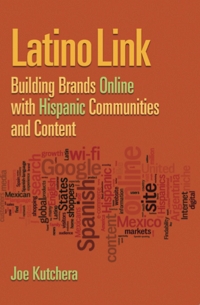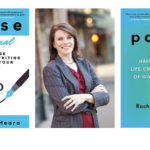This is the first in a three-part series on how to write a book, based on my experience of writing my first book. Read Part II (on writing and editing your book) and Part III (on how to promote your book using social media).
Do you write down your annual or five year goals? I started writing mine down when I was a teenager. My father encouraged me to do so at the beginning of every calendar year.
In reviewing mine from a few years ago, I included “write a book” in my five-year plan. Little did I know that that dream would come to fruition so quickly. Paramount Books published my first book, Latino Link: Building Brands Online with Hispanic Communities and Content in 2010. It’s a funny story about why it happened so quickly. More on that in a bit.
Since then, I’ve met many authors and re-connected with many of my business contacts, friends, and blog readers who have considered writing one themselves. Many have asked me, “How did you find a publisher? How did you plan and schedule the writing of your book? And, how do you promote it?” In the interest of sharing what I’ve learned during this journey with all of you who want to write a book, here you go. Steal these suggestions!
Many of the tips here I gleaned from numerous authors, publishers, editors and publicists and the team at Porchlight Books (formerly 800-CEO-Read). In addition, Jack Covert, the company’s founder, shared his advice on how best to promote a business book. He would know. He’s the author of The 100 Best Business Books of All Time: What They Say, Why They Matter, and How They Can Help You.
Process for Writing Your Book
How many books are published every day? Around 2,500. So, how will yours stand out amidst the enormous amount of competition? That’s the key question to figure out before you start writing yours.
And what are the steps in writing a book?
- Pitching: Finding the right publisher for your book
- Writing and research: The Fun Part
- Editing: The Hard Part
- Marketing: Getting your book out there
- Social media marketing: Building your personal brand
Now, with that overview, here’s the story of how I wrote and published Latino Link, and the experts that I met along the way, whose advice can help you accomplish your goal of writing your book.
Pitching Your Book and Finding a Publisher
I first pitched the idea for my book at SXSW Interactive following a panel discussion called, “So, you want to write a book?” Authors, agents and publishers shared their perspectives on how to pitch and write a business book. The authors on the panel emphasized that books don’t make you money. Instead, their books established them as a thought leader in their area of specialty.
After the panel, I spoke with an internal agent at New Riders/Peach Pit Press (two imprints of Pearson), about my idea for my book. He said, “It sounds great. Let me send my book proposal template.” Two months later, I emailed him my detailed outline, sample chapter, and marketing plan for my book to be. He promised to pass it around to his colleagues saying it looked good.
Two weeks later, I thought, “Wouldn’t it be great to have time off to write my book.” The following week, I returned to my office (at a late-stage media startup) after a business trip to discover that 10% of the company had been laid off, including me. Lesson learned: be careful what you wish for!
Good Advice: Look for Agents in the Acknowledgements of Similar Books
Chiqui Cartagena, author of Latino Boom!: Everything You Need to Know to Grow Your Business in the U.S. Hispanic Market, gave me some good advice while pitching my book. Identify books in the same genre as yours. Carefully study the acknowledgements in books that inspired you to write yours. Who do the authors thank and which agent or publisher contact did they work with? Reach out to those people about your book by saying, “I liked the book that you worked on by [author’s name]. I thought you might be interested in my book, which is very similar to [book’s name] that I saw you work on.”
Chiqui then suggested that I contact Paramount Books, which focuses on publishing multicultural marketing and marketing research books. Four weeks after introducing me to Jim Madden at Paramount, we ironed out our contract.
Chiqui also cautioned me that even authors published by Random House, the massive book company that published her book, need to dedicate a lot of time and effort to promote their own books. More on that later in the marketing and social media overview.
As a point of comparison, Adrian Zackheim the founder of Portfolio, Penguin’s dedicated business imprint, says that he regularly commissions books with well-known authors and journalists. In addition, he and his team look at a lot of proposals via literary agents or directly from authors themselves. Agents, in his case, help his team weed through all of the proposals out there to find good ones.
In contrast, Greenleaf Book Group, much like Paramount Books, works directly with authors to shape their books (instead of agents). Clint Greenleaf, the company’s founder, evaluates books by asking a few key questions: How is your book new and different from what’s out there? What is the chance that the book will be successful? Does the book challenge conventional thinking? The bottom line: Does your proposal convince a publisher about why your book will be a success?
Writing Your Book Proposal
When you write your proposal, how you can highlight your own personal brand? Do you write a column for a business or trade publication? Which conferences have you spoken at? What companies have you worked at? How many readers visit your blog? In other words, how does your platform already position you to sell your book and the core idea that you represent? iMedia and MediaPost had both given me the opportunity to write for them prior to pitching my book, which made my proposal more appealing to Paramount. If you don’t write a column or blog, launch one. It’s a great platform to start putting ideas out there and getting feedback on what you write.
Traditional Publisher? Or Self-Publish?
While some authors find a traditional publisher, others self-publish their books. Increasingly, this has become a good option. Once you set up your ISBN number and listing on Amazon, the leading search engine for books, social media platforms can help you raise awareness and drive sales of your book. Will Meyerhofer, wrote his book – Life is a Brief Opportunity for Joy – to showcase his approach to psychotherapy and promote his practice. After numerous attempts to find an agent or publisher, he decided to launch his blog – The People’s Therapist – and self-published his book.
Today, that option can actually lead to getting noticed by traditional publishers and even a book contract. This article from The Wall Street Journal – As You May Have Read in My Book… – highlights how the self-publishing route often works best for entrepreneurs. The subtitle of the story explains why: “More Entrepreneurs and Professionals Embrace Self-Publishing as Way to Burnish Credentials and Attract New Customers.”
In conclusion, here’s a handy step-by-step process about “How to Self-Publish a Book.” Some of the leading self-publishing companies include Lulu, iUniverse, Xlibris, and Amazon’s CreateSpace.
Continue reading my tips on how to write, edit and promote a book in Part II (on writing and editing your book) and Part III (on how to promote your book using social media).







